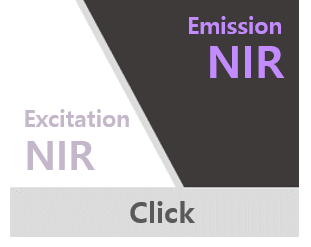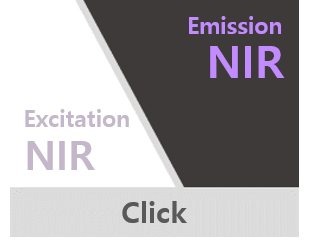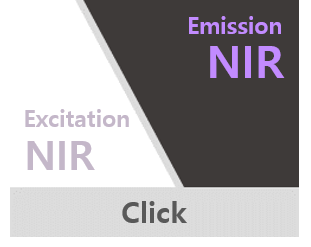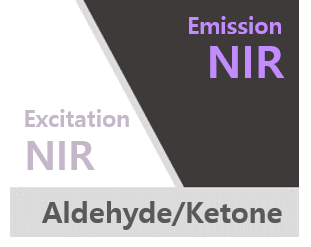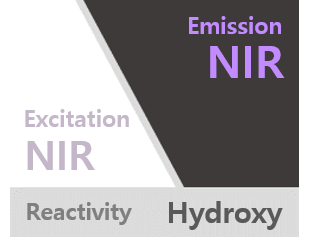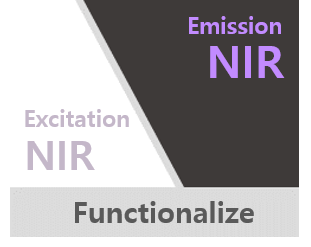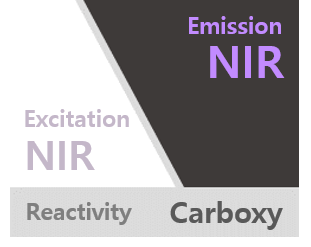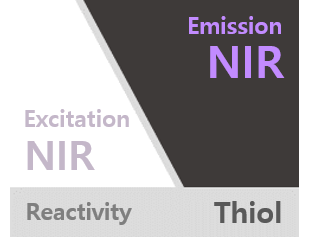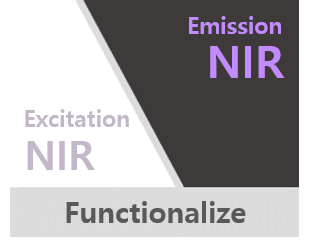
ICG Azide
| PACKING UNIT | price |
Lead time |
|---|---|---|
| 1 mg | $153.00 | |
| 5 mg | $454.00 | |
| 25 mg | $1,704.00 |
Description
ICG Azide is a copper (I)-catalyzed azide-alkyne cycloaddition (CuAAC) reagent of near infrared (NIR) fluorescent dye and used to generate a stable fluorescence signal in bioimaging. NIR fluorescence allows to observe the deep image from the surface of skin and being utilized in a wide range of research fields. The maxima of Ex/Em values are at 785/812 nm. ICG might be excited using 750-800 nm laser line or LED and displays excellent optical property. ICG azide couples with an alkyne to form 1,4-disubstituted 1,2,3-triazole inside of living systems without interfering native biochemical processes. Prior to perform CuAAC, counterpart alkyne functionality should be introduced onto biomolecule by means of chemical or genetic modification. We offer ICG azide as a click chemistry reagent dye for cellular imaging and nucleotide functionalization.
Citation & Reference
1. Wu Y, Miniature NIR-II nanoprobes for active‐targeted phototheranostics of brain tumors. Advanced Healthcare Materials. 2022 Nov 7;11(23).
2. Choi J, Development of intraoperative near-infrared fluorescence imaging system using a dual-CMOS single camera. Sensors. 2022 Jul 26;22(15):5597.
3. Luo X, Metabolizable near-infrared-II nanoprobes for dynamic imaging of deep-seated tumor-associated macrophages in pancreatic cancer. ACS Nano. 2021 Jun 1;15(6):10010–24.
4. Tsujimoto A, Different hydration states and passive tumor targeting ability of polyethylene glycol-modified dendrimers with high and low peg density. Materials Science and Engineering: C. 2021 Jul;126:112159.
5. Lee A-J, Application of elastin-like biopolymer-conjugated C-peptide hydrogel for systemic long-term delivery against diabetic aortic dysfunction. Acta Biomaterialia. 2020 Dec;118:32–43.
6. On KC, Tumor-targeting glycol chitosan nanoparticles for image-guided surgery of rabbit orthotopic VX2 lung cancer. Pharmaceutics. 2020 Jul 3;12(7):621.
7. Chang KH, Comparison of salbutamol delivery efficiency for jet versus mesh nebulizer using mice. Pharmaceutics. 2019 Apr 19;11(4):192.
8. Cherukula K, “navigate-dock-activate” anti-tumor strategy: Tumor Micromilieu charge-switchable, hierarchically activated nanoplatform with ultrarapid tumor-tropic accumulation for Trackable Photothermal/Chemotherapy. Theranostics. 2019;9(9):2505–25.
9. Bell G, Functionalised Iron Oxide Nanoparticles for multimodal optoacoustic and Magnetic Resonance Imaging. Journal of Materials Chemistry B. 2019;7(13):2212–9.
10. Aaron M. Mohs. An integrated widefield imaging and spectroscopy system for contrast-enhanced, image-guided resection of tumors. IEEE Trans Biomed Eng 62.5 (2015): 1416-24.
11. Mohammed Hassan. Near Infrared Fluorescence Imaging with ICG in TECAB Surgery Using the da Vinci Si Surgical System in a Canine Model. J Card Surg 27.2 (2012): 158-162.
12. Mitsuharu Miwa. The Principle of ICG Fluorescence Method. The Open Surgical Oncology Journal 2 (2010): 26-28.
OPTION
Total

 log
log My
My Contact
Contact

